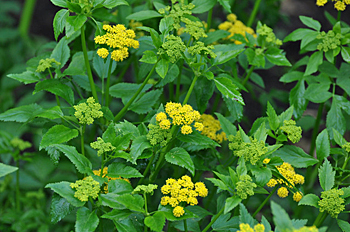Volume 25 Issue 2, Spring 2020
by Hope Woodward
Without a doubt, one reason to include Golden Alexander (Zizia aurea) in your garden is that it is one of the “Super 9” native plants that support local pollinators, native bees, and butterflies. It’s a valuable food source and larval host for the Black Swallowtail caterpillar, while its pollen is collected by small bees (think green sweat bees), larger bees sip its nectar, and Ladybird Beetles are reported to lay eggs under the flowerheads. During the spring and early summer before many other plants bloom, it serves as a nectar source for beneficial insects with short mouthparts. To top it off, deer seem to steer clear of Z. aurea and it has few pest and disease problems.

Golden Alexander in bloom.
Photo by Ann Garvey
Aside from its benefits to wildlife, the gardener will welcome Golden Alexander’s versatility: it grows in full sun to light shade and will tolerate full shade. Although Z. aurea prefers moist to wet, well-drained sandy-clay soils that are acidic to neutral, it can handle sites with rocky material and survive dry summers. The plant is very easy to grow and self-seeds. In fact, plants can reseed heavily under ideal conditions; consider deadheading seed heads to discourage large colonies.
Z. aurea occurs from Maine to Florida and west from Montana to Texas in USDA hardiness zones 4-9. It is found in both higher quality and degraded habitats such as moist black soil prairies, openings in moist to mesic woodland edges, wooded bottomlands, stream banks, floodplains, meadows, power line clearings, and abandoned fields.
In our area come mid-March, the dark green, somewhat glossy, compound serrated leaflets of this deciduous short-lived perennial sprout out of the ground from dense clusters of coarse fibrous roots. Golden Alexander grows upright in 12-inch diameter clumps that grow to 1.0-2.5 feet. By late spring and through early summer, showy blooms appear at the ends of the plant’s upper stems in the form of a flat umbel. These tiny, bright chartreuse-yellow flowers are a pollinator magnet! As the summer heat increases, Zizia aurea’s flowers begin to bolt and its foliage takes a downturn. However, Z. aurea keeps on giving year-round: as the seed heads dry, they turn purple and, according to Native American Butterfly Association member Mary Ann Borge: “Even after the fruit falls or is eaten, the flower pedicels (stems) offer an attractive starburst shape for visual interest when left standing through the winter.”
Consider using Golden Alexander in a perennial border, to line the edges of a driveway, in a rock garden, or in a rain garden.
You can find Golden Alexander at the Loudoun Wildlife Conservancy-sponsored spring and fall native plant sales in Morven Park and also at many local native plant nurseries.
Resources:
Digital Atlas of the Virginia Flora
Friends of the Wild Flower Garden, Inc., Plants of the Eloise Butler Wildflower Garden
Lady Bird Johnson Wildflower Center
Native American Butterfly Association
Native Plants for Northern Virginia
Plant the ‘Super 9’ for Pollinators and They Will Come

